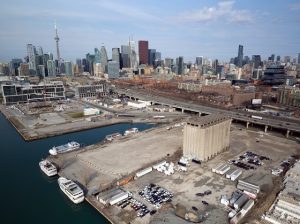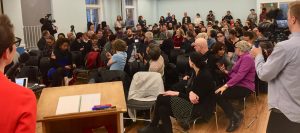Plans for a smart city along the waterfront of Toronto have been derailed. But sidewalks are still key to a liveable city. Paintbrushes, too!
The highly-sensored, data-driven community known as Quayside was to have been developed with Sidewalk Labs, one of the many technology companies (including Google) under the Alphabet corporate umbrella. The development was to be “a testbed for emerging technologies, materials and processes that will address pressing challenges in developing more sustainable, accessible, inclusive and prosperous communities, and advance solutions that can be replicated in cities worldwide.”
Those challenges would eventually prove too great to overcome: Sidewalk blamed global economic uncertainty in the midst of the coronavirus pandemic for derailing the project, saying the current fiscal situation triggered a need for enhanced efficiencies in the company.
As opposed to, say, opposition on the lakeshore.
The Resistance was Not Futile

Quayside, the proposed smart neighbourhood in Toronto will also be a test lab for big data analytics.
From the moment the project was first announced, it was seemingly positioned as a done deal. A fantastic high-tech wonderworld is coming to Toronto, gushed political and corporate leaders. Driven by visions of a thriving, tax-generating high-tech enabled economy, an empty chunk of neglected waterfront property would be digitized and a safe, affordable, and efficient neighbourhood would be the result.
Yet almost immediately, concerns, criticisms, and controversy swirled around the project.
Not only local citizens and community groups, but data privacy experts, intellectual property lawyers, technology leaders, advocates for open democratic governance, human rights organizations and more have voiced their concerns.
Sure, the idea that sidewalks and lampposts and garbage cans would be tracking and analyzing our every move for the cause of greater efficiency and efficacy seemed attractive. But who would have access to all that data? Who would store it, and where? Who would most benefit from it, and why?

One of the first meetings of the Block Sidewalk group demonstrated the degree of concern about announced plans for Quayside. BSW image.
As a testbed for the city of tomorrow, third-party technology and application developers were invited to participate and benefit by joining in. They would be given access to neighbourhood data and infrastructure so as to improve or enhance their products; licensing arrangements were expected to come forth as the company moved Quayside-tested tech to other smart cities around the world.
Yet intellectual property considerations and licensing guidelines left some worried that their contributions would not be fairly recognized or compensated.
Amidst all these concerns, the idea that a private, for-profit company could in many ways supersede the authority or mandate of elected public representatives may have been the tipping point. How could societal oversight be applied to the project’s development and operation if private industry, not the public, was in the driver’s seat?
Eventually, concerns over governance aspects of the project and the handling of gathered citizen data resulted in the resignations of outside project advisors, including Dr. Ann Cavoukian. She’s a former Privacy Commissioner of Ontario, and she’s credited with developing the concept called Privacy by Design.
The fact that concerns about data privacy and security were voiced in the public reaction to Sidewalk Toronto plans was a pleasant surprise to Cavoukian.
“I am astounded at the attention on this; I never expected all the attention and positive responses. People are listening to the issues, they are discussing the issues. If nothing else, that’s the good impact from all of this.”
TechGirls Canada founder Saadia Muzaffar also left her advisory position, writing at the time that project participants and organizers show “a blatant disregard for resident concerns about data” and citing additional concerns about intellectual property protections
If futility did raise its head during the project’s aborted lifespan, it may not have been in the multi-layered objections to the project, but in the estimated $16 million spent by public agencies on the proposals.
Yet the project still can point the way to urban enhancements and better cities.
We Can Still Walk the Walk (if we widen our sidewalks)
If COVID killed the Sidewalk project, it has also shown us how important sidewalks are: think of certain urban initiatives in place to accommodate social distancing requirements. We know that safe spaces are important at any time, but especially so now. Cities are widening their pedestrian sidewalks by closing an adjacent lane of automobile traffic (there’s still room for cars, albeit somewhat less is needed in the height of the lockdown).
A “walkable city” is the dream of Robin Mazumder; he’s a doctoral candidate in cognitive neuroscience at the University of Waterloo, a Fellow at the Centre for Urban Design and Mental Health, and (when possible) a world traveller.
That interesting combination of training, research, and experience leads him to place liveability as key to the success of any city. And walkability is an important part of that: to start with, it can bring health and wellness to regular practitioners. And it means more of the city is available and accessible, especially to seniors and the physically challenged. Hey, for Canadians in winter, that’s a lot of us.
So in that light, a snow shovel and a sense of shared community can be just as valuable as a smart, sensored, heated chunk of concrete beneath our feet.
Paintbrushes can be a big help, too.

A paintbrush is a smart tool, according to New York City’s experiences described by Janette Sadik-Khan, the former Transportation Commissioner.
That’s according to Janette Sadik-Khan, the former Transportation Commissioner for New York City. In her book that recounts her experiences trying to enhance liveability in the Big Apple, called Streetfight, she relates how “[s]imply painting a part of the street to make it into a plaza or bus lane not only made the street safer, but it also lessened congestion and increased foot traffic, which improved the bottom line of businesses.”
It’s clear that our cities need an upgrade; what we are working with now hasn’t changed substantively in like 50, 60, or a hundred years. Time for version 2.0! Equity, accessibility, health, safety, and security are smart new features we could all use.
Examples like these are among many to show that tangible, meaningful, and universal changes can be made to our cities much more simply and easily than we might have thought. Effectively and efficiently, too. And yes, the changes could be made “smartly” with the judicious use of technology.
But we should also add “ethically”.
Late last year, Toronto city council voted to join the Cities for Digital Rights and sign a pledge to develop a code of ethical digital standards and technological practices to be implemented across all city departments.
One hopes that commitment lasts a bit longer than Quayside did.
-30-



